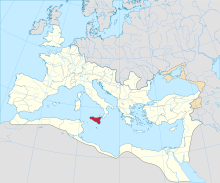
Back Sicilia (Romeinse provinsie) Afrikaans سيشيليا (مقاطعة رومانية) Arabic Сицилия (римска провинция) Bulgarian Província romana de Sicília Catalan Sicílie (provincie) Czech Sicilia (talaith Rufeinig) Welsh Sicilia (Provinz) German Sicilia Esperanto Sicilia (provincia romana) Spanish Sitsiilia (Rooma provints) Estonian
| Sicilia Σικελία | |||||||||||
|---|---|---|---|---|---|---|---|---|---|---|---|
| Province of the Roman Empire | |||||||||||
| 241 BC–476 AD | |||||||||||
 The province of Sicilia within the Roman Empire, c. 125 AD | |||||||||||
| Capital | Syracusae | ||||||||||
| Historical era | Antiquity | ||||||||||
• Established after the end of First Punic War | 241 BC | ||||||||||
• Fall of the Western Roman Empire | 476 AD | ||||||||||
| |||||||||||
| Today part of | Italy Malta | ||||||||||
Sicilia (/sɪˈsɪliə/; Classical Latin: [sɪˈkɪ.li.a]; Ancient Greek: Σικελία, romanized: Sikelía) was the first province acquired by the Roman Republic, encompassing the island of Sicily. The western part of the island was brought under Roman control in 241 BC at the conclusion of the First Punic War with Carthage.[1] A praetor was regularly assigned to the island from c. 227 BC.[2] The Kingdom of Syracuse under Hieron II remained an independent ally of Rome until its defeat in 212 BC during the Second Punic War.[3] Thereafter the province included the whole of the island of Sicily, the island of Malta, and the smaller island groups (the Egadi islands, the Lipari islands, Ustica, and Pantelleria).
During the Roman Republic, the island was the main source of grain for the city of Rome. Extraction was heavy, provoking armed uprisings known as the First and Second Servile Wars in the second century BC. In the first century, the Roman governor, Verres, was famously prosecuted for his corruption by Cicero. In the civil wars which brought the Roman Republic to an end, Sicily was controlled by Sextus Pompey in opposition to the Second Triumvirate. When the island finally came under the control of Augustus in 36 BC, it was substantially reorganised, with large Roman colonies being established in several major cities.
For most of the Imperial period, the province was a peaceful, agrarian territory. As a result, it is rarely mentioned in literary sources, but archaeology and epigraphy reveals several thriving cities, such as Lilybaeum and Panormus in the west, and Syracuse and Catania in the east. These communities were organised in a similar way to other cities of the Roman Empire and were largely self-governing. Greek and Latin were the main languages of the island but Punic, Hebrew and probably other languages were also spoken. There were several Jewish communities on the island and from around AD 200 there is also evidence of substantial Christian communities.
The province briefly fell under the control of the Vandal kingdom of North Africa shortly before the collapse of the Western Roman Empire in 476, but was soon returned to the Kingdom of Italy and returned to Roman control under the eastern emperor at Constantinople to which it would remain until the 9th century.
- ^ "Appian, Sicily and the Other Islands, Fragments, section 2". data.perseus.org. Retrieved 2017-03-03.
- ^ Brennan, T. Corey (2000). The praetorship in the Roman Republic. Oxford; New York: Oxford University Press. pp. 91–93. ISBN 0195114590. OCLC 41503761.
- ^ Cartwright, Mark. "Syracuse", World History Encyclopedia, 28 April 2011